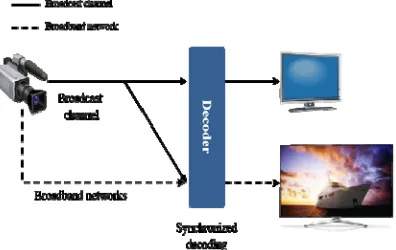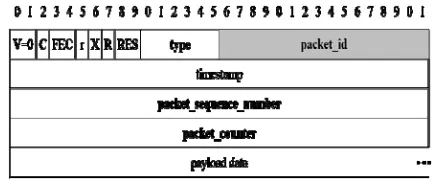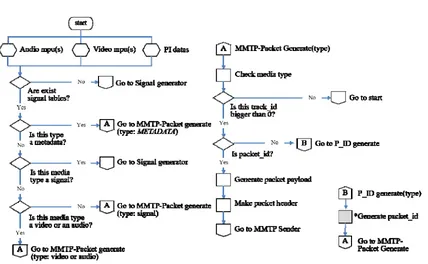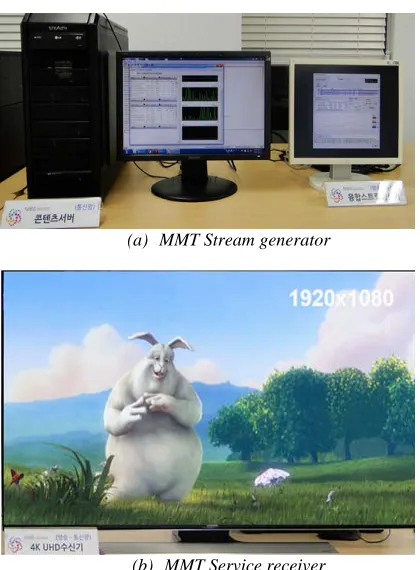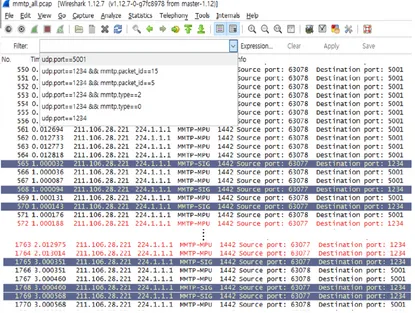346
DESIGN AND IMPLEMENTATION FOR MEDIA-AWARE
TRANSMISSION METHOD BASED ON MMT
1JONGHO PAIK, 1 SONGYEON LEE, 1KYUNGA YU
1Department of Software Convergence, Seoul Women’s University, Korea
E-mail: 1 paikjh@swu.ac.kr
ABSTRACT
Ultra-High-Definition (UHD) broadcasting, which is one of advanced broadcasting technologies, has met the user’s needs for high-definition and realistic services. By the way, UHD content is too large to be transported due to the limited bandwidth of existing HD broadcasting systems. In order to solve this problem, a lot of advanced broadcasting technologies have been suggested. One of the related researches proposed a UHD broadcasting service that each layer of video separated hierarchically are transmitted over heterogeneous networks. Unlike the existing MPEG-2 TS based on stream mode, UHD contents are transmitted based on packet mode. Therefore, to ensure the Quality of Service (QoS) of UHD content against inevitable packet delay, the UHD broadcasting system has to be taken into account the priorities of transmission depending on type of media and the layers of video simultaneously. In this paper, we propose a media-aware transmission method and also experimental results will be shown to verify the effectiveness of the proposed method.
Keywords: MPEG Media Transport, Transmission Model, Scheduling, UHD, Hybrid Broadcasting System
1. INTRODUCTION
As video technology and device performance has been improved, users do demand ultra-high definition, realistic media ever before. In order to satisfy the user's needs, UHD broadcasting service that combines UHD video and multi-channel audio has been discussed. However, UHD requires a lot of data compared with existing HD. Therefore, it is difficult to transport such large amounts of data over the existing broadcasting network with limited bandwidth.
To solve this problem, some studies suggest advanced broadcasting technologies of scalable high-definition video codec (SHVC) and hybrid networks [1][2]. In [1], the service that each layer of video separated hierarchically is transmitted over the different networks has been proposed. Before sending the videos, the transmission system performs encapsulation and packetization by MMT protocol. The MMT, which is standardized by MPEG is independent on the network because it is designed based on the IP [3].
Unlike the existing MPEG-2 TS system based on stream mode, UHD media contents in MMT-based system are transmitted based on packet mode. Therefore, to ensure the QoS of UHD content against inevitable packet delay, the UHD
broadcasting system has to be taken into account the priorities of transmission depending on type of media and the layers of video simultaneously [4].
In this paper, we propose a media-aware transmission method of ensuring the QoS of UHD content against inevitable packet delay. Also, experimental results will be shown to verify the effectiveness of the proposed method.
2. MATERIALS AND METHODS
2.1 Hybrid delivery
347 broadcast channels and broadband networks. In case of encoding some UHD media data into a base layer and an enhancement layer using the SHVC, each layer can be delivered to a broadcast channel and a broadband network as shown in Fig. 1.
2.2 ISO base media file format
ISO base media file format (ISO/IEC 14496-12 - MPEG-4 Part 12) defines a general structure for time-based multimedia files such as video and audio [5][6]. The identical text is published as ISO/IEC 15444-12 (JPEG 2000, Part 12) [7]. It is designed as a flexible, extensible format that facilitates interchange, management, editing and presentation of the media. The presentation may be local, or via a network or other stream delivery mechanism. The file format is designed to be independent of any particular network protocol while enabling support for them in general [6] It is used as the basis for other media file formats (e.g. container formats MP4 and 3GP). There are also related file formats that use the structural definition of a box-structured file as defined in the ISO Base Media File Format, but do not use the definitions for time-based media. Other files using this structure include the standard file formats for JPEG 2000 images .
[image:2.612.313.523.91.157.2]A simple format of media data file is shown in Fig. 2. Fig. 2. is simple format of the media data file. This is constrained by ISOBMFF only in that the media-data in the media file must be capable of description of the metadata [8]. The metadata is the values indicated by the letter as ‘moov’ or ‘mdat’. The track identifiers are unique within that file. More than two tracks shall not use the same identifier. The next track identifier value is stored in next_track_ID in the Movie Header Box. This enables easy generation of a track identifier.
[image:2.612.94.292.568.693.2]Figure 1: Hybrid Delivery of Content for various environments
Figure 2: Simple Format of Media Data File
2.3 Scalable HEVC
Next generation image compression technology having higher compression ratio and relatively lower complexity than existing image codec is required due to high data rate is required to provide UHD ultrahigh quality image to users. The ITU-T Video Coding Experts Group (VCEG) and ISO / IEC MPEG agreed to jointly work on the next generation video standardization and established a collaborative team called Joint Collaborative Team on Video Coding (JCT-VC).
Compared with the MPEG-TS used in the basic broadcasting system, the compression performance is improved by about 80% [9]. In order to improve the compression efficiency, a new method such as CTU (Coding Tree Unit) structure, motion compensation, and the like has been applied to the new compression technique.
Even if the HEVC having the improved compression performance is used, it is difficult to provide a stable service for using the existing broadcasting network in the light of transmitting UHD contents. Therefore, in order to maintain an ultra-high resolution or super high image quality, a method of hierarchically compressing the corresponding content and providing it through a heterogeneous network has been considered.
To overcome the drawbacks of existing SVC, JCT-VC developed SHVC as a HEVC-based SVC standard technology. SHVC, which is based on the proposed HEVC technology for compressing super high resolution images, is a technology that
compresses super high resolution images
hierarchically and adaptively converts them in various transmission environments. In general, SHVC can be mainly divided into base layer and enhancement layer. There are a number of enhancement layers, and they are encoded based on HEVC.
348 implementation complexity and increase the coding efficiency,
The SHVC had been designed using a new technique of a reference image index approach that adds images of a lower layer to a reference image list of an upper layer and a multi-loop decoding method that decodes all lower layers that can be referenced.
2.4 MMT protocol
Since the MPEG-2 TS packets used in the existing broadcasting do not coincide with the IP packet structure used in the Internet, it is inconvenient to apply different encoded data in order to transmit the same video to the broadcasting and the Internet simultaneously. At the time of enactment of the MPEG-TS standard, the speed of the Internet was not enough to provide stable video streaming services and there was no consideration.
However, since multimedia contents can be provided through various networks such as broadcasting network, wired / wireless internet, and cellular communication network, a system that can be applied to various networks is required more than a system having a structure suitable for a single network.
As mentioned earlier, MMT succeeds MPEG-2 TS as the media transport solution for broadcasting and IP network content distribution, with the aim of serving new applications like UHD, second screen, etc., with full support of HTML5
and simplification of packetization and
synchronization with a pure IP based transport. It has the following technology innovations:
Convergence of IP transport and HTML5
presentation
Multiplexing of various streaming
components from different sources
Simplification of TS stack and easy
conversion between storage file format and streaming format
Support multiple devices and hybrid delivery
Advanced QoS/QoE engineering features
The MMT protocol is an application layer transport protocol that is designed to efficiently and reliably delivery of packages. A package is a logical entity and shall contain one or more presentation information documents, one or more assets as shown in Fig. 3 [3] . The asset is a collection of one
[image:3.612.313.522.196.297.2]or more media processing units (MPU) that share the same asset ID. An asset contains encoded media data such as audio or video, image or text, or a web page. The Presentation Information (PI) documents specify the spatial and temporal relationship among the assets for consumption. The PI documents are included in the signaling messages required to be sent in advance to the configuration of the receiver.
Figure 3: Components f MMT package
Figure 4: Structure of MMT packet header
An MMT packet consists of a payload data and a header as shown in Fig. 4. The payload is one of the MPUs, signaling messages and generic files. Each packet may have its own header depending on the type of the payload.
type (6 bits) - this field indicates the type of
payload data such as MPU, Generic object, signaling message, etc.
packet_id (16 bits) - this field can be used to
distinguish on asset from another.
packet_sequence_number (32 bits) - this field
is used to distinguish packets that have the same packet_id.
packet_counter (32 bits) - this field counts
MMT packets are sent regardless of its packet_id.
[image:3.612.309.525.326.416.2]349
Figure 5: MMT based Transmission Model
Figure 6: Flow chart of MMTP Generator
3. DESIGN OF MEDIA-AWARE TRANSMISSION MODEL BASED MMT
3.1 Structure of transmission model
In this paper, we proposed a design scheme of media-aware transmission model. As shown in Fig. 5, transmission model based MMT consists of 3 Module, MPU Generator, MMTP Generator and MMTP Sender, respectively. Encoded media data, such as a piece of audio or video content, constitutes an Asset. A video content is separated hierarchically into 3 layers which
[image:4.612.95.523.278.542.2]350 In MMTP Generator, each MMT packets including MPUs or signaling messages is given to the packet_id through P_ID Generator. The packet_id can be used to distinguish on Asset from another. The MMTP Sender schedules the MMTP packets which made in accordance with the rule for generation of the packet_id. The scheduler can determine the repetition rate according to the type of media. And it puts priority on the importance of the media. After scheduling, the sender connects to connection type and it transmits the data. For example, the audio or signaling message, base layer and enhanced layer of separated video layers are transmitted to the broadcasting network. The extended layer is transmitted to the communication network as described in Section 2.
3.2 The proposed rule for generation packet_id
A flowchart of the MMTP generator is shown in Fig. 6. First, input data such as audio, video, or PI data is checked and classified into types of media such as signal, metadata, video, or audio. The classified media type is the type of MMT payload. If there is a signal table in the next step, it checks the type of metadata and branches to the MMTP packet generator if not. Otherwise, it branches to the signal generator. In case the signal is a media data type, it branches to the signal generator. Otherwise, it branches to the MMTP packet generator if it is a media type video or audio.
The MMTP packet generator checks the type of the media data. If the track_id is greater than 0 and the packet_id is 0, the packet payload is generated and sent to the MMTP sender. If it is not a packet_id, it branches to the P_ID generator, and next, it creates a packet_id according to the packet_id rule proposed in this paper and sends it to the MMTP packet generator. The square box marked with * symbol in Fig. 6 include the proposed packet_id generation rule as mentioned. According to the rule, the packets may have their own packet_id depending on the type of the
payload. Then, MMT packets send to the MMTP Sender.
AAAA - represent the media type with 4bit.
The media type is as follows.
BBB - represent a track_id generated from
MPU. In case of the video, track_id adds depending on the layer like Fig. 3. There can be up to 8 tracks.
CCCCCCCCC – represent packet_id with 8
bits
Table 1 shows the types, corresponding values, and data definitions for the media types defined above. One thing to note is that the data is divided into timed and non-timed media. This is highly related to real-time processing of media data at the receiver. Data with time information is represented according to a timetable, and synchronization is required at the decoding and display time. Data that does not include time information is not related to other data, but the time to configure the screen can be determined by the response according to the request of the user or the screen configuration information.
The MPUs which consists of an asset including data with time information cannot overlap the screen configuration time. Because the asset as a set of MPUs which is closely related to the PI that is the screen configuration information, it must be included in the time and the asset or PI
provided according to the user's request.Therefore,
in the case of hierarchically structured content, the content is divided into MPUs in respective assets. And the PI should record the information that the provided media must include a hierarchical structure and the path and configuration information for the base layer and the enhancement layer.
Table 1: Values of media type
Value Media type Definition of data
0x00 Video timed media data for video streaming (h264, h265, avi)
0x01 Text non-timed data (txt, xml, rtf)
0x02 Application non-timed data (jsp, php, html)
0x03 META contains the movie fragment metadata or MPU metadata
0x04 Image non-timed media (bmp, png, jpg, jpeg)
0x05 Signaling message one or more signaling messages
0x06 ~ 0x0E Reserved for future used reserved
0x0F Audio timed media data for audio streaming(aac, mp3, mpa)
351
4. EXPERIMENTAL RESULTS
4.1 Structure of transmission model
A proposed transmission system in this paper is shown in Fig. 7. Fig. 7-(a) shows the stream generator and the contents server. Fig. 7-(b) shows the network independent broadcasting service receiver. The stream generator of Fig. 7-(a) acquires each of video and audio stream input and generates MMTP packet. At that point, it can assign a packet ID using proposed method to identify separate media type. It is scheduled to be sent, according to type of media and also separated by the packet ID. At the stream generator, contents server accepts MPU input through FTP. It provides the MPU through the HTTP, when the user requests it. Fig. 7-(b) shows the MMT receiver. It can receive MMTP packet and then re-organizes media data to play. Both MMTP generator and MMT receiver shown in Fig. 7-(a) and Fig. 7-(b) were developed on the Windows environment with CPU i5 or higher.
(a) MMT Stream generator
(b) MMT Service receiver Figure 7: The proposed system of sending/receiving
model
Table 1 shows the setting values of contents to be used to send/receive. All of the media data are separated for each layer have been generated as a separate packet. The packet was sent after creating the packet ID through the proposed method. The packet_id and scheduling option
[image:6.612.313.526.158.301.2]generated by the proposed method are listed in Table 2. The Packet generated with packet ID generated by the proposed method is sent after scheduling.
Table 2: Properties of used contents
Type Properties Coding scheme Encoding S/W
Video
FPS 30
SHVC SHM 10.0 Intra
Period 32
Input Resolution
1280x720 1920x1080 3840x2160
Audio Bitrate 48MHz AAC ffmpeg
[image:6.612.90.300.350.635.2]Channel 2Channel
Table 3: Example of scheduling option and packet_id
Table 4: Experimental results (unit: millisecond)
Only signal Rule of Packet_id
Big Buck Bunny
Best case 11 4.9
Worst
case 1011 9.7
According to two criteria, the packets can be classified in order to evaluate the performance of the generation rule of the “packet_id” introduced in Section 3.2. One uses only the signaling information as “Only signal” and the other uses the “packet_id” adapted by the proposed generating rule as “Rule of Packet_id” listed in Table 4, respectively. In case that the proposed rule is adapted because the receivers can discriminate which type of data is in this packet before entirely parsing its header, the input speed at its own buffer can be faster. Therefore, we expect that the delay in service at the receiver side can be reduced. We also
Media Type
(Layer) Packet_id Repeat Priority
Network Type (Address:port)
Video
(1) 0x0000 - 5 (192.168.0.14:1234)UDP Video
(2) 0x0020 - 4
UDP (192.168.0.14:5001) Video
(3) 0x0040 - 3
FTP (192.168.0.21) Audio
(1) 0xF000 - 5
UDP (192.168.0.14:1234) Signal
(1) 0x5000 True 8
352 test two cases as the best and worst cases. The best one is assumed that the receiver can obtain packets for the signaling messages as soon as a user accesses a service and on the other hand, the worst case is assumed that a user can access the packets immediately after the signaling messages are passed.
Table 4 shows the performance of the generation rule of the “packet_id” introduced in Section 3.2. The times as shown in Table 4 indicate the times required to receive the first pictures of all hierarchically encoded streams be inputted into a decoder buffer and also represent the average value of 10 test times. According to the test results, we found the case where both the signaling messages and rule of “packet_id” are used has a low service delay and also we can verify the good performance of the proposed rule against to the worst case.
4.2 Structure of transmission model
For the verification of the proposed system, we have used Wireshark which is convincing as a network analyzer as shown in Fig. 8. The Wireshark version is 1.12.7. The video for
the experiment was used as indicated in the Big Buck Bunny as shown in Fig. 7-(b). But, the Wireshark doesn’t provide a MMT protocol, it was added using Lua script for packet filtering.
udp.port = = 1234 (1)
udp.port = = 1234 && mmtp.type = = 0 (2) udp.port = = 1234 && mmtp.packet_id = = 15 (3)
[image:7.612.100.515.392.705.2]where (1) means port number. Through the port 1234 is audio, signaling message and the base layer of the separated video hierarchically transmitted. Through the port 5001 is the enhanced layer of video transmitted. (2) means an MPU of the video. Although the existing MMT packet header could distinguish the MPU, signaling message or generic file through type of media, it couldn’t know whether the MPU is the video or audio. The proposed method can distinguish layers of video as well as audio and video only by checking the packet_id. (3) means an audio transmitted to the 1234 port. Also, using the scheduling the packet_id, it was confirmed that the signaling can be transmitted repeatedly.
353
5. CONCLUSIONS
Ultra-High-Definition (UHD) broadcasting, which is one of advanced broadcasting technologies, has met the user’s needs for high-definition and realistic services. By the way, UHD content is too large to be transported due to the limited bandwidth of existing HD broadcasting systems. In order to solve this problem, a lot of advanced broadcasting technologies have been suggested. One of the related researches proposed a UHD broadcasting service that each layer of video separated hierarchically are transmitted over heterogeneous networks.
Unlike the existing MPEG-2 TS based on stream mode, UHD contents are transmitted based on packet mode. Therefore, to ensure the Quality of Service (QoS) of UHD content against inevitable packet delay, the UHD broadcasting system has to be taken into account the priorities of transmission depending on type of media and the layers of video simultaneously.
In this paper, we proposed the media-aware transmission method of ensuring the QoS of UHD content against inevitable packet delay by using packet_id. To verify the effectiveness of the proposed method, transmission model, the rule of generation of packet_id and experimental results were presented. We assumed that the best case is assumed that the receiver can obtain packets for the signaling messages as soon as a user accesses a service and on the other hand, the worst case is assumed that a user can access the packets immediately after the signaling messages are passed.
According to the test results, we found the case where both the signaling messages and rule of “packet_id” are used has a low service delay and also we can verify the good performance of the proposed rule against to the worst case. As a result, we presented that the proposed method can easily and concisely find out the audio, video, signaling message or metadata, respectively.
In the near future, further research is essentially needed to apply the proposed the rule of generation of packet_id to 8K UHD content composed of four 4K UHD contents, which is more crucial to service delay due to massive data size of 8K UHD content against to a 4K UHD content.
ACKNOWLEDGMENTS:
This research is supported by Ministry of Culture, Sports and Tourism(MCST) and Korea Creative Content Agency(KOCCA) in the Culture
Technology(CT) Research & Development
Program 2017 [R2017030041, Experience
Maximization Technology for Cultural Contents at Free Selection View].
REFRENCES:
[1] Y. Sohn, M. Cho, M. Seo, and J. Paik, A Synchronization Scheme for Hierarchical video Streams over Heterogeneous Networks, KSII, vol.9, no.8, 2015, 3121-3135.
[2] Wassim Hamiouche, Mickael Raulet and Olivier Deforges, Multi-core software architecture for the scalable HEVC decoder, IEEE International Conference on Acoustic, Speech and Signal Processing(ICASSP) (2014), 7595-7599. [3] ISO/IEC 23008-1, Information technology –
High efficiency coding and media delivery in heterogeneous envitonments – Part1: MPEG media transport (MMT), 2014.
[4] Xiaoqing Zhu and Bernd Girod, Video streaming over wireless networks, Signal Processing Conference 15th European (2007), 1462-1466 [5] ISO (2008). "Information technology - Coding
of audio-visual objects - Part 12: ISO base media file format; ISO/IEC 14496-12:2008"
(PDF). International Organization for
Standardization: 88, 94. Retrieved 2009-07-29. [6] ISO (2004). "Information technology - Coding
of audio-visual objects - Part 12: ISO base media file format; ISO/IEC 14496-12:2004". Retrieved 2009-07-29.
[7] ISO (2004). "Information technology - JPEG 2000 image coding system - Part 12: ISO base media file format; ISO/IEC 15444-12:2004". Retrieved 2009-07-29.
[8] ISO/IEC 14496-12, Information technology – Coding of audio-visual objects – Part12: ISO base media file format, 2015.
